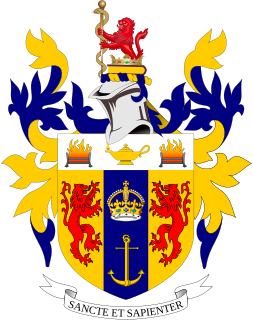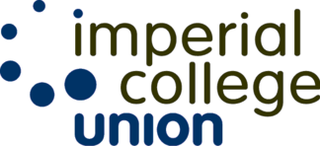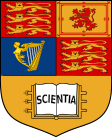
Imperial College London is a public research university in London, United Kingdom. Its history began with Prince Albert, consort of Queen Victoria, who developed his vision for a cultural area that included the Royal Albert Hall, Victoria & Albert Museum, Natural History Museum and royal colleges. In 1907, Imperial College was established by a royal charter, which unified the Royal College of Science, Royal School of Mines, and City and Guilds of London Institute. In 1988, the Imperial College School of Medicine was formed by merging with St Mary's Hospital Medical School. In 2004, Queen Elizabeth II opened the Imperial College Business School.

The University of Manchester is a public research university in Manchester, England. The main campus is south of Manchester City Centre on Oxford Road. The university owns and operates major cultural assets such as the Manchester Museum, The Whitworth art gallery, the John Rylands Library, the Tabley House Collection and the Jodrell Bank Observatory—a UNESCO World Heritage Site.
The Royal College of Science was a higher education institution located in South Kensington; it was a constituent college of Imperial College London from 1907 until it was wholly absorbed by Imperial in 2002. Still to this day, graduates from the Faculty of Natural Sciences at Imperial College London receive an Associateship to the Royal College of Science. Organisations linked with the college include the Royal College of Science Union and the Royal College of Science Association.

King's College London is a public research university located in London, England. King's was established by royal charter in 1829 under the patronage of King George IV and the Duke of Wellington. In 1836, King's became one of the two founding colleges of the University of London. It is one of the oldest university-level institutions in England. In the late 20th century, King's grew through a series of mergers, including with Queen Elizabeth College and Chelsea College of Science and Technology, the Institute of Psychiatry, the United Medical and Dental Schools of Guy's and St Thomas' Hospitals and the Florence Nightingale School of Nursing and Midwifery.

Kean University is a public university in Union and Hillside, New Jersey. It is part of New Jersey's public system of higher education.

The University of Redlands is a private university headquartered in Redlands, California. The university's main, residential campus is situated on 160 acres near downtown Redlands. An additional eight regional locations throughout California largely provide programs for working adults.

The Royal School of Mines comprises the departments of Earth Science and Engineering, and Materials at Imperial College London. The Centre for Advanced Structural Ceramics and parts of the London Centre for Nanotechnology and Department of Bioengineering are also housed within the building. The school as an organisation no longer exists, having been incorporated into the Faculty of Engineering since 2003. Today the Royal School of Mines refers to both the departments associated with the former school, and the Grade II listed Edwardian building by Sir Aston Webb, which is viewed as a classic of academic architecture. The building and relevant student union still carry the name.

Transylvania University is a private university in Lexington, Kentucky. It was founded in 1780 and was the first university in Kentucky. It offers 46 major programs, as well as dual-degree engineering programs, and is accredited by the Southern Association of Colleges and Schools. Its medical program graduated 8,000 physicians by 1859.

Northern Kentucky University is a public university in Highland Heights, Kentucky. It is primarily an undergraduate institution with over 14,000 students; over 12,000 are undergraduate students and nearly 2,000 are graduate students. Northern Kentucky University is the third largest university, behind the University of Cincinnati and Miami University, of Greater Cincinnati's four large universities and the youngest of Kentucky's eight, although it joined the state system before the University of Louisville. Among the university's programs are the Salmon P. Chase College of Law and the College of Informatics, founded in 2006.

Imperial College Union is the students' union of Imperial College London. It is host to many and varied societies, and has student bars situated around Albertopolis. The Union is based in the north wing of the Beit Quadrangle on Prince Consort Road.
Imperial College School of Medicine (ICSM) is the undergraduate medical school of Imperial College London in England, and one of the United Hospitals. It is part of the college's Faculty of Medicine, and was formed by the merger of several historic medical schools, with core campuses at South Kensington, St Mary's, Charing Cross, Hammersmith and Chelsea and Westminster. The school ranked 3rd in the world for medicine in the 2022 Times Higher Education World University Rankings.

Westminster College is a private college in Fulton, Missouri. It was established in 1851 as Fulton College. America's National Churchill Museum is a national historic site located on campus. The school enrolled 609 students in 2020.

Imperial Valley College is a public community college in Imperial County, California. It was founded in 1962 and enrolls around 7,000 students per year. In April 2022, Lennor M. Johnson, Ed.D., was appointed president of the college. The main campus is located on a 160-acre (0.65 km2) site in the city of Imperial with extended campuses in El Centro and Brawley.
The Royal College of Science Motor Club was set up in 1955 to maintain "Jezebel", a 1916 Dennis N-Type fire engine and a mascot of the students of the Royal College of Science, one of the founding three colleges of Imperial College London, in South Kensington.
The City and Guilds College Union represents students who are undertaking courses from the departments of Aeronautical, Chemical, Civil, Design, Electrical, and Mechanical Engineering, together with Bioengineering and Computing at the college. Other students within the faculty are represented by the Royal School of Mines Students' Union. These follow the names of two of the three former 'Constituent Colleges' that formed Imperial in the early 20th century. The City and Guilds Union's name derives from the original City and Guilds College from which the faculty was formed. The union hosts an annual welcome dinner, and members of the union are traditionally known as Guildsmen and Guildswomen. The students' union brings together the 8 departmental societies, and organises events throughout the year, and to welcome new students.

The Faculty of Engineering is the engineering school of Imperial College London, and one of the three main faculties the college. It was formed in 2001 from the former City and Guilds College and the Royal School of Mines—two of the three original constituent colleges of Imperial College when the latter was formed in 1907. The faculty is located at Imperial's main South Kensington campus, where teaching and research take place.

The Faculty of Natural Sciences is one of the three main faculties of Imperial College London in London, England. It was formed in 2001 from the former Royal College of Science, a constituent college of Imperial College which dated back to 1848, and the faculty largely consists of the original departments of the College. Undergraduate teaching occurs for all departments at the South Kensington campus, with research being split between South Kensington and the new innovation campus at White City.

Imperial College School of Medicine Students' Union (ICSMSU) is the students' union of the Imperial College School of Medicine. It is charged with representing and advocating for the educational, pastoral, social and extracurricular needs of all the undergraduate students within the Faculty of Medicine of Imperial College London, and is a constituent union of Imperial College Union.

The Blackett Laboratory is part of the Imperial College Faculty of Natural Sciences and has housed the Department of Physics at Imperial College London since its completion in 1961. Named after experimental physicist Patrick Blackett who established a laboratory at the college, the building is located on the corner of Prince Consort Road and Queen's Gate, Kensington. The department ranks 11th on QS's 2018 world university rankings.

The history of Imperial College London can be traced back to the founding of the Royal College of Chemistry in 1845 in London, with some ancestral medical schools dating back to 1823. The college was formed in 1907 out of the Royal Colleges in South Kensington, and throughout the 20th century became central to the national strategy for technical education and research. It existed for most of its life as part of the University of London, only becoming independent in 2007.
















